The Courtenay Airpark Association believes the city is trying to close down this unique facility on the Vancouver Island coast. In a presentation to City Council today, Airpark volunteers will detail its economic, social and lifestyle benefits for the community
Editor’s note: this story was updated at 9 a.m. to include a Medivac helicopter landing at the Airpark last night due to unfavorable conditions at the hospital heli-pad.
Fearing that someone at Courtenay City Hall wants to turn the Airpark into a condo development, pilots and aviation business owners will pitch the facility’s economic benefits at 4 p.m. today (Aug. 7) to the City Council.
Closing the Courtenay Airpark would shutter several aviation businesses and put roughly 50 people out of work, not to mention the estimated indirect loss of more than $20 million in spin-off economic activity, social benefits and the displacing of 72 private aircraft to other Island communities.
So who is trying to close the Airpark?
Mo Perry, president of the Courtenay Airpark Association, isn’t sure. But he says the signals started well before city staff released a proposed update to its transportation plan that shows a new bridge going directly through the Airpark.
The city, which owns the Airpark land, has been converting leases for aviation businesses, hangars and the volunteer association that runs the aerodrome from a five-year term to month-to-month.
“No business can operate on month-to-month leases successfully,” Perry says. “The uncertainty stifles investment and growth.”
Al Pheaton’s International Aeroproducts Inc. employs 15 tradesmen and up to 30 during the busy winter months fabricating floats for seaplanes and during major restorations of Beaver and Otter aircraft. It’s known worldwide in the aviation community as one of the best in the business.
Pheaton’s business is so successful that he needs to expand his floorspace either into a second, separate building or by adding on to the existing one. But he can’t get approval from the City of Courtenay.
“And anyway, what bank is going to loan money to a business for expansion on a month-to-month lease,” Perry said.
FURTHER READING: Battle brewing over transportation plan; City bridge proposal would harm Airpark, Kus-kus-sum
The Courtenay Airpark is unique in British Columbia because it is accessible for both wheel and float planes. Pilots can bring their floatplanes in for repair and leave via wheeled planes.
But the city has been stalling a long, overdue restoration of the float plane ramp, despite provincial and federal support and approval for the project.
So when the proposed transportation plan update came out with a road and bridge through the Airpark’s runway, Perry said the city’s plan became obvious.
But Airpark volunteers don’t know who at city hall is trying to drive them out.
Current Mayor Larry Jangula and the three mayoralty candidates — David Frisch, Erik Eriksson and Bob Wells — have all previously told Decafnation that Airpark volunteers and business owners shouldn’t worry about the proposed third crossing at 21st Street.
“It’s just a concept,” Jangula said.
Decafnation emails Jangula and the three mayoralty candidates yesterday (Aug. 6) and asked if they were in favor of closing the Courtenay Airpark and using the land for some other purpose:
Eriksson said, “I like the Airpark.”
Frisch said, “That question has too many unknowns to give a yes or no answer. I do value the airpark amenity, but I must stay open to all possibilities for this city owned asset.”
Wells and Jangula did not reply.
Other organizations, like Project Watershed, are also alarmed by the 21st Street bridge proposal. A roadway and bridge there would slice Hollyhock Marsh in half and affect the group’s future restoration of the old Field’s Sawmill site, known now as Kus-kus-sum. The group has said it would oppose any crossing south of 17th Street.
Comox Valley Nature President Jim Boulter has said his organization is also opposed to the 21st Street bridge proposal.
Hollyhock Marsh is provincially owned and protected land, so it’s somewhat unlikely the city would be allowed to build a bridge through it.
But Perry and other Airpark volunteers, like Dave Mellin, worry that abandoning the bridge proposal won’t diminish the city’s attacks on the Airpark despite its 2016 Official Community Plan that requires council to “protect the integrity of the airpark and marina facilities at 20th Street; work with non-profit societies to improve and expand facilities as required.”
“The Airpark is the only park owned by the city that actually generates revenue,” Perry said. “All of their other parks cost the city money.”
WHAT’S AT STAKE
The Airpark was originally built by local pilots in the early 1960s. Eric Franklin was the first pilot to land there — on a gravel runway — in September of 1964.
Since its origin 55 years ago, all the improvements to the facility — except for provincial grants for paving the runway and installing an underground fuel system — have been funded from Airpark revenue or through volunteers.
Airpark businesses that include aircraft maintenance, flight schools and timber cruising have created up to 50 direct jobs and roughly 90 indirect jobs, producing about $50,000 in revenue annually for the city.
More than 700 student pilots and in excess of 200 air force cadets have completed their training at the Airpark. There are two Ministry of Transport approved flight schools on site.
The RCMP use the Airpark regularly, and it will continue to be used for patient transfers on Medivac flights because certain weather conditions will impede landing at the new hospital. A Medivac helicopter landed at the Airpark at 6 p.m. last night (aug. 6) because conditions at the hospital helipad were unfavorable.
“Can’t imagine landing on that hospital heli-pad on a typical Comox Valley blistery winter day with a loaded chopper,” Perry said.
In the event of an emergency, such as an earthquake, the Airpark is the only facility on the west side of the river for evacuation or medical transportation if bridges and roads are disabled.
CFB Comox 4 Construction Engineering Squadron does annual testing of the Airpark runway to ensure that it’s safe for certain military air operations if needed, such as Buffalo and helicopters.
WHO USES THE AIRPARK
Andreas Ruttkiewicz, a former military jet pilot, runs the Air Speed High Ultralight flight school. He started his business in 2007 in Victoria and moved it to Comox in 2011. He trains about 12 to 15 pilots a year.
Sealand Flight, a pilot training and aircraft rental company based in Campbell River, plans to open a Courtenay operation this month. It trains pilots for recreational, private and commercial certification.
International Aeroproducts Inc. is currently doing a complete restoration of a classic Beaver float plane and building sets of floats for several others, including a customer from Panama.
A Texada grocery store flies a Cessna 172 into the Courtenay Airpark three times every week to purchase products for resale to island residents. It’s less expensive and quicker than resupplying via ferry and ground transportation.
Land surveyor Dave Bazett houses two aircraft at the Airpark, one is an iconic de Havilland Beaver float plane that he uses in his work up and down the coast.
Mike Hamilton houses a helicopter at the Airpark used in his logging business, an operation he wants to expand.
On a tour Aug. 4 of the Airpark, Decafnation met several fliers.
Courtenay resident Karina Bakker (also A Mt. Washington ski patrol) just purchased a Cessna 172 on floats in Manitoba and flew it back to the Airpark. She was recently employed by Coril Air doing charter flights out of Campbell River.
“On the coast, there’s no freedom like flying with floats,” she said.
George and Cheryl T. (who asked to keep their last name private) flew in from Abbotsford on a Eurocopter EC120 helicopter with their two daughters to meet up with friends for a cruise on their catamaran sailboat.
Cheryl, who used to live in the Comox Valley, is also a pilot and has flown in and out of the Airpark often.
“This is a classic airport of the type we need to protect,” she said.


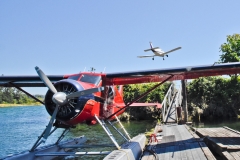
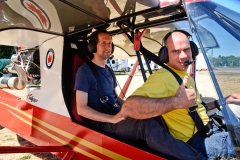
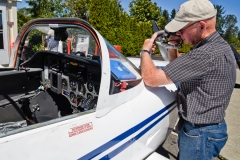
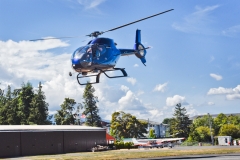
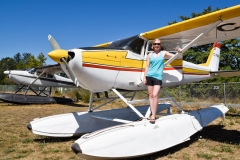
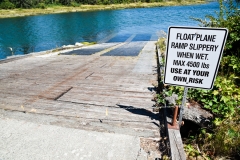
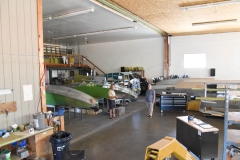
Keep working the publicity for the economic, social and MEDEVAC. Angles to keep this in front of the people of Courtney. A partnership with the habitat concerned individuals would also be beneficial.
We shall know who on Council will protect the Airpark on Monday at the council meeting as the agenda states a vote to give the airpark a long term lease is supposed to take place. We shall see who is for and who is against the Airpark. Then we may know just who will be on the next council as the majority of the Valley sure want it just as it is.